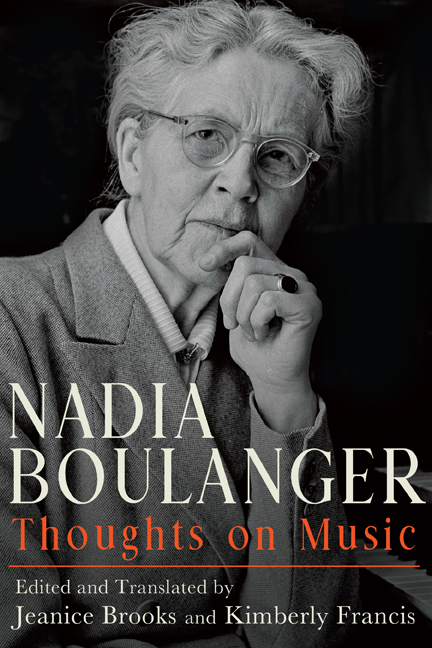Book contents
- Frontmatter
- Contents
- List of Illustrations
- Acknowledgments
- Editorial Apparatus and Critical Notes
- Note on Translations
- List of Abbreviations
- Timeline of Nadia Boulanger’s Life
- Introduction
- Part One Journalism, Criticism, Tributes
- Part Two Lectures, Classes, Broadcasts
- Bibliography of Nadia Boulanger’s Published Writing
- General Bibliography
- Index
“Walter Damrosch et le New-York Symphony Orchestra à Paris,” Le Monde musical 31, nos. 9–10 (May 1920): 156–57 (complete text)
Published online by Cambridge University Press: 15 October 2020
- Frontmatter
- Contents
- List of Illustrations
- Acknowledgments
- Editorial Apparatus and Critical Notes
- Note on Translations
- List of Abbreviations
- Timeline of Nadia Boulanger’s Life
- Introduction
- Part One Journalism, Criticism, Tributes
- Part Two Lectures, Classes, Broadcasts
- Bibliography of Nadia Boulanger’s Published Writing
- General Bibliography
- Index
Summary
Works Reviewed (all concerts at the Théâtre de l’Opéra)
May 6, 1920
Benvenuto Cellini, op. 23, “Overture,” Hector Berlioz
Symphony no. 3 “Eroica,” E-flat major, op. 55, Ludwig van Beethoven
Istar, op. 42, Vincent d’Indy
Daphnis et Chloé, Maurice Ravel
May 8, 1920
Le Roi d’Ys, “Overture,” Edouard Lalo
Symphony no. 9, E minor, op. 95, Antonín Dvořák
Violin Concerto no. 3, D minor, op. 61, Camille Saint-Saëns
Pelléas et Mélisandre, op. 80, Suite, “II: Fileuse,” and “Entr’acte to Act III,” Gabriel Fauré
Ma mère l’Oye, “III: Laideronnette, impératrice des pagodes,” Maurice Ravel
Die Meistersinger von Nürnberg, WWV 96, “Prelude,” Richard Wagner
May 9, 1920
Symphony no. 41 “Jupiter,” C major (K. 551), Wolfgang Amadeus Mozart
Poème: Scène dramatique, Charles Martin Loeffler
Symphony, César Franck
Rhapsodie nègre, John Powell
An American orchestra has just been heard in Europe for the first time.
What are the origins of this orchestra? What is its role? What are its resources? What is its worth?
Founded in 1878 by Leopold Damrosch, the first to perform Berlioz and Wagner in America, the New York Symphony Orchestra has been directed by Mr. Walter Damrosch since 1885. Continuing what his father created, he in turn resolved to be the pioneer of music and to consecrate the greatest part of his life to it, at first because he loved it, and then because he felt the ardent desire to make his compatriots love it better.
The task he then undertook has never been abandoned, and it would be difficult to imagine what proportions it has attained had the history of the Society not provided edifying proof, attesting to the incredible labor.
One can say that all the important works of every country, and of nearly every era, are represented. The care with which they have been performed is also obvious: in such a way as not to produce fatigue or disorder of the mind—equally evident is with what effort to introduce them, to shed light on them, to establish them, they have been played and replayed, toured from city to city. Then, judging that, in order to entirely complete this useful work, it is necessary to prepare the younger generations to know how to listen and how to understand, Mr. Walter Damrosch organized concerts for children: concerts in which verbal explanation alternates with listening to pieces.
- Type
- Chapter
- Information
- Nadia BoulangerThoughts on Music, pp. 117 - 122Publisher: Boydell & BrewerPrint publication year: 2020



